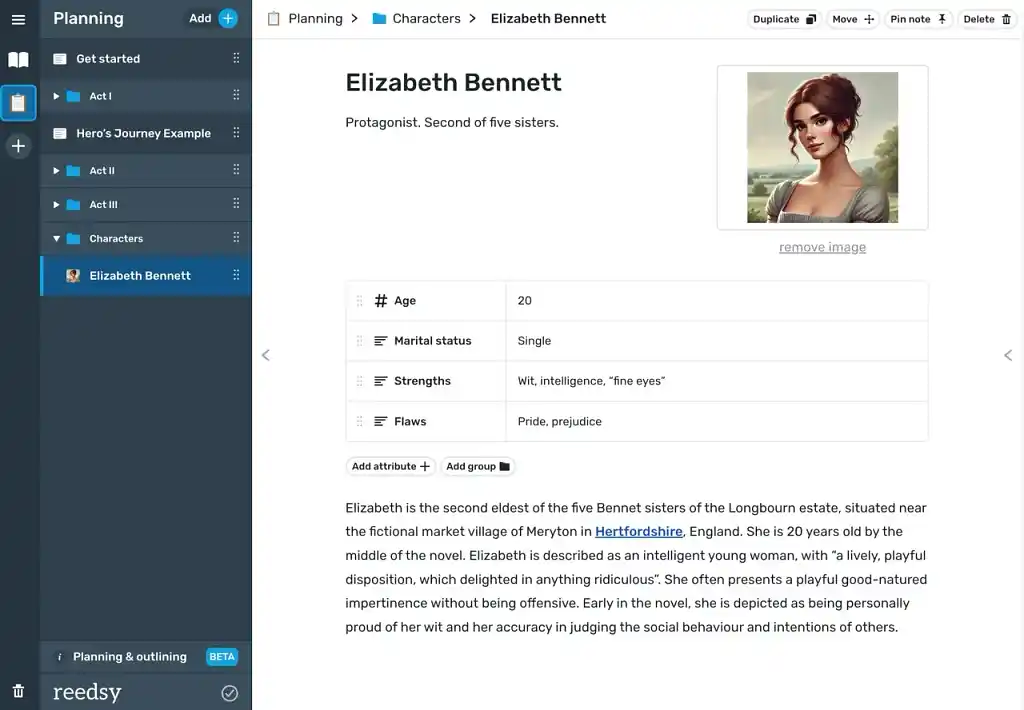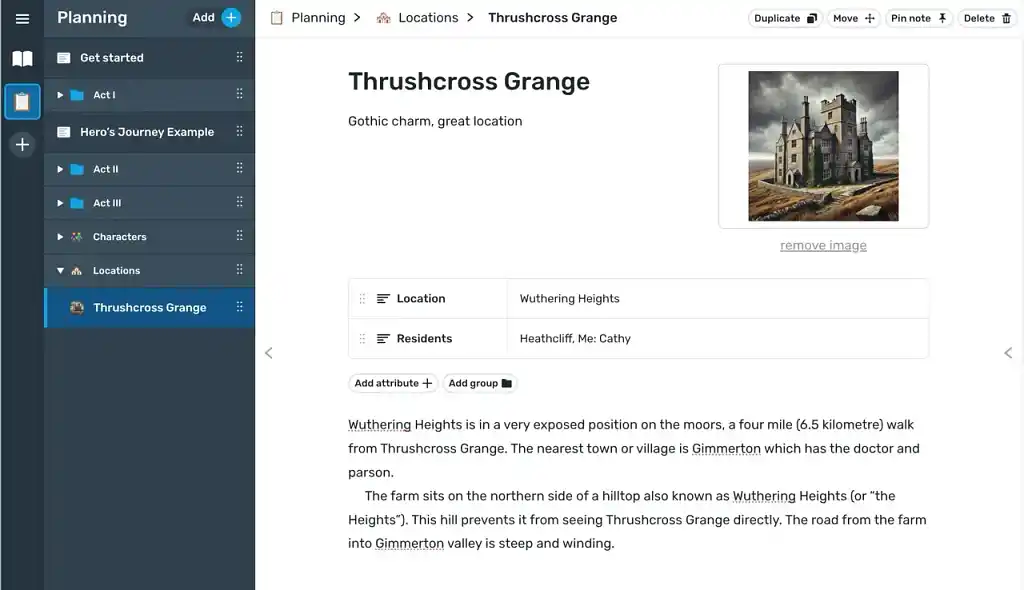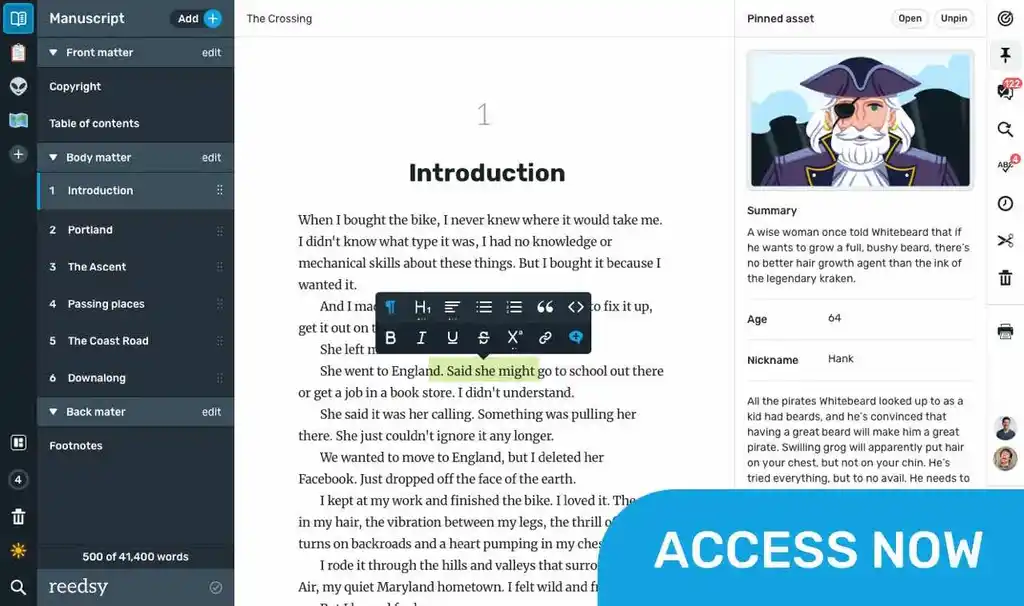So you want to be a storyteller, eh? Well, whether you’re an aspiring novelist or a seasoned writer, mastering the basic elements of storytelling is key to capturing your audience’s attention and imagination. In this guide, I’ll show you my favorite method for coming up with ideas and spinning them into a workable story.
You ready? Let’s go.
1. Brainstorm for potential ideas
Inspiration often strikes in unexpected ways. But we can’t just sit back and wait for ideas to pop into our heads: you have to actively seek them to spark your creativity. You can draw from personal experiences, news stories, or even dreams.
Mary Shelley’s Frankenstein was inspired by a conversation about galvanism (the act of re-animating dead muscle with electricity) and a vivid nightmare. J.K. Rowling outlined much of Harry Potter while on a train, letting her ideas flow freely before organizing them. (One can speculate that’s where the idea for the Hogwarts Express came from.)
I like to get my ideas from observing the banal everyday activities of strangers — then trying to puzzle out what brought them to this point. This method, I find, not only helps you arrive at an interesting scenario but also with a central character. If you’re interested, I made a video about this process that you might find useful.
Tip: Keep a notebook handy to jot down ideas that come from daily life or moments of curiosity. Observe people in their everyday lives and ask yourself, ‘Why are they doing that?’
2. Engage in some character development
Character is at the heart of everything in a story. Without dynamic and relatable characters, you won’t have a story that people will want to read. (Mind you, ‘relatable’ doesn’t have to mean ‘likable.’) Now, there are a few key elements that I believe are crucial in a protagonist:
- They must have strengths and flaws.
- These strengths and flaws should be central to the story.
- The character must change in some way.
Think of Elizabeth Bennet from Pride and Prejudice, who is witty, vulnerable, and stubborn. Mr. Darcy is attracted to her wit and intrigued by her vulnerability. However, her stubbornness (i.e., prejudice!) proves to be a major obstacle in the story — and it’s only when Lizzy realizes her own flaws and changes that she finally gets what she wants.
Tip: Create character bios to try to understand their personalities and backstories. And don’t be afraid to return to change these bios as your story develops.

3. Choose a suitable point of view
The viewpoint you choose shapes your readers’ connection to the story. Close first-person narration, like in Charlotte Brontë’s Jane Eyre, offers the reader a sense of intimacy with the character — while third-person omniscient can present a broader view of the story that spans space and time.
The narrator of The Book Thief by Markus Zusak is Death himself, a choice that provides an unusual and haunting perspective on the events of Nazi Germany. It’s a curious combination that marries first-person narration with omniscience — two aspects Zusak carefully balances to give readers a unique and emotionally engaging experience.
Of course, selecting the right point of view can be daunting. You might feel limited by the constraints of a single perspective or struggle to maintain consistency when switching between multiple viewpoints. Just remember, once you’ve chosen a POV, it can be very hard to change it in the edit.
Tip: Experiment with different POVs in short scenes to find the one that best suits your story’s needs. Consider how each perspective affects the tone and reader experience and, most importantly, figure out which one you actually enjoy writing the most.
4. Map out your world (metaphorically)
A vivid setting immerses readers in your world — your goal is to transport them to a time and a place in which they’ll want to spend time. While your setting doesn’t have to be 100% true to life (one could argue that the Victorian London of Dickens’ novels is as ‘realistic’ as Tolkien’s Middle-earth), there has to be a consistency and internal logic to the way your world works.
In addition, I think it’s important to think about how your characters fit into this world. For example, in Wuthering Heights, the wild and windy Yorkshire Moors are a reflection of Heathcliff, one of the main characters. The windswept isolation and ruggedness serve as an external representation of Heathcliff’s intense emotions. When Cathy enters this world as an outsider, she is overwhelmed by the setting, just as she is by Heathcliff.
Tip: Create a dossier of your story’s locations. You can search for images or use ChatGPT to create reference ‘photos.’

5. Give your plot a structure
A well-structured plot keeps readers engaged and entertained by ensuring that the story is always progressing. Many writers have a finely attuned sense of plot structure simply because they’ve been reading and writing stories for years.
When you’re starting off, don’t be afraid to try out structures like the three-act structure, the Hero’s Journey, or the Save the Cat beat sheet to guide your narrative. You might think that these frameworks are only for certain types of stories — fantasy novels, thrillers — but they can be applied to almost any narrative.
As an out-there example, we could look at something like The Babysitters Club (as low-stakes a narrative as one could hope for) and map the plot onto a three-act structure:
- Kristy is the smallest girl in her year (Exposition).
- She gets the idea to start a babysitting service (Inciting Incident).
- She recruits her friends, and they start getting work (Rising Action).
- They must balance sibling rivalries, schoolwork, and personal secrets (Midpoint).
- We learn that Stacey — the new girl — is secretly battling diabetes (Plot Point 2).
- They all open up to each other, become better friends, and the Babysitters Club is up and running (Climax and Denouement).
So, if you’re unsure where your story should be going at any given moment, why not refer to a popular framework and see if it inspires you?
Tip: Create a plot outline or timeline to visualize key events and turning points.
6. Figure out what conflict lies at its center
One could argue that conflict is a story’s engine, driving its tension and stakes. In every good story, your character should find themselves dealing with internal and external conflict — two fights that should ideally complement one another.
As an example, in Harry Potter and the Order of the Phoenix, Harry faces significant external challenges: the increasing threat posed by Voldemort, the Ministry of Magic’s refusal to acknowledge You-Know-Who’s return, and Dolores Umbridge, a new professor with oppressive rules. Simultaneously, Harry is grappling with feelings of isolation, frustration, self-doubt and anger as he copes with the traumatic events of the previous book (Goblet of Fire).

The interplay between these conflicts makes Harry’s journey compelling. His internal growth — learning to put more faith in others and himself — helps him to face these external threats. This balance between internal and external challenges gives the story emotional depth and keeps readers engaged.
Tip: Develop conflicts that pose a challenge to your protagonist’s beliefs or goals. Consider how these challenges shape their growth and drive the story’s resolution.
7. Explore some interesting themes
When talking about ‘theme,’ I try to focus on the intent of the story. It’s usually a message or idea that the author is trying to convey. Theme is what makes a narrative resonate — it’s the thing that can transform a plot about rabbits into a story that gets readers to think about the impermanence of life.
Harper Lee’s To Kill a Mockingbird is more than just a plot about a lawyer and his curious daughter. It explores themes of justice, empathy, and moral growth, all of which remain relevant decades after its publication.
Balancing the narrative’s entertainment value with meaningful thematic exploration can be tricky. Indeed, writers often struggle with integrating themes subtly without being didactic. If it feels like you’re forcing a theme or overtly moralizing, this can alienate readers.
Tip: Focus on showing, not telling, your theme. Use your characters and how they deal with conflict to illustrate your message rather than stating it outright.
8. Write evocative dialogue
I find this is the part that most writers really enjoy: it’s a chance for us to get into the heads of our characters and live in their shoes — or is it in their mouths? Just remember that when you’re writing dialogue, the main purpose should be to reveal character and propel the plot.
In Of Mice and Men by John Steinbeck, the rapport between George and Lennie is simple, yet deeply revealing of their relationship and individual personalities. Lennie’s repetitive and childlike speech contrasts with George’s practical tone: a yin and yang, highlighting their bond and dependence on each other.

At the start, you may struggle with making characters’ voices distinct or balancing dialogue with exposition. Dialogue that feels stilted or overly expository can disrupt the flow of the narrative. But don’t worry: that’s what the editing is for.
Tip: Read anything by Ernest Hemingway and you’ll quickly see how sparse, purposeful dialogue can reveal character and evoke emotion.
9. Revise and edit mercilessly
Think of your first draft as collecting raw material. The real craft of developing your story comes afterward, as you edit that draft into a polished narrative. Look for inconsistencies, tighten prose, and refine character arcs.
You’ll often hear the maxim “kill your darlings,” which alludes to the fact that an author’s favorite parts of their work are often also the most self-indulgent — and should be the first to face the chopping block. Letting go of scenes or characters that don’t serve the story can be emotionally taxing, but it must be done. (If you struggle to do this yourself, consider hiring an editor who can evaluate your work more objectively.)
Balancing macro edits (like plot structure) with micro edits (like grammar and style) can feel overwhelming. It isn’t easy, but eventually, you’ll start to see the forest for the trees as you trim away the fat and leave only a lean, muscular manuscript that’s ready to face the world.
Tip: Take breaks between writing and editing to gain a fresh perspective. Share your work with beta readers or critique partners who can provide constructive feedback. And, as mentioned, consider working with a professional editor who can bring their knowledge of the industry to bear on your manuscript.

Meet some of the world's best editors today.
The best professionals are already on Reedsy. Sign up now to request free quotes.
By mastering these elements, developing captivating stories will soon become second nature to you. Keep experimenting, learning, and revising — the journey of storytelling is as rewarding as the destination.












How do I create an organic subplot that is not in the story just for the sake of being in the story?
Marissa - About 8 years ago
Hi Marissa, thanks for the question. This blog post here should help: https://www.nownovel.com/blog/subplot-ideas-better-subplots/ I'd say make sure you link the subplot to the action in your main arcs (e.g. what actions by your main characters could cause your subplot to unfold?). Also think about how a subplot could show themes in your story from new angles. Good luck!
Bridget At Now Novel - About 8 years ago
this is very good service.
Saleel - Over 6 years ago
My prompt was to write what does it mean to be a family? But I don't know how to make it interesting. Can you please give me ideas or suggestions.
Chrissy - Over 6 years ago
Well maybe getting weird situations in front of the family or you can take different families and keeping the same theme use different situation with each .. i m a nub myself so don't judge me
Saharsh - Over 5 years ago
Chapters...as in actual Chapters? Or is that just parts?
Jaquses - Over 5 years ago
In this case it would be parts (if you're referring to the episode outline example in the article, Jaquses).
Jordan At Now Novel - Over 5 years ago
Under Step 5 the link doesn't seem to be working.
Ash - About 5 years ago
Thank you for letting us know, Ash! I've fixed it, thank you for reading our articles.
Jordan - About 5 years ago
Some of this is helpful. I remember the Doctor Who novels of the 1960s and 1970s that were written by the same writers who scripted for the show. The TARDIS lands and quickly the Doctor is separated from either one or all of his companions. Then there are adventures had by both Doctor and companions that lead to the final solution. I like that and that is how my own novels currently develop.
Rodney Marsden - Almost 5 years ago
Hi Rodney, thank you for your feedback! I'm glad some was helpful. Your description of Dr Who reminds me of that Bradbury quote that 'plot is nothing more than footprints left by your characters in the snow'. This 'scenario + surprising events within that scenario' type of loose structure does work well for adventure novels, as they tend to be more episodic (e.g. Homer's Odyssey). I would say if you've found an approach to story development that works for you (and for a reader), definitely run with it.
Jordan - Almost 5 years ago
Don't forget to familiarize yourself with Greek tragedy, the epitome of what a compelling story is. I suggest starting with Oedipus Rex. If there ever were a good story with loads of incredible tension baked in, that's the one.
Rsd Owens - Over 4 years ago
That's a great recommendation, RSD, thank you. I played Tiresias once (many years ago) in a high school production. Greek myth, too. Thank you for reading our blog.
Jordan - Over 4 years ago
I am an aspiring writer but have no idea where to even start in developing a storyline. Where is a good place that can teach world building and basic writer tips?
Liz - Over 4 years ago
Hi Liz, thank you for asking us. We have a free 5-day email mini-course on worldbuilding you may find helpful, you can subscribe to the lessons here. Alternatively, here is our category page for all our posts on worldbuilding. As for developing a storyline, starting with a core central idea or scenario is a good first step. Here are some tips for developing that further once you have a premise. Let me know if you have any questions!
Jordan - Over 4 years ago
This was so helpful! I have not thought to study effective examples of plot development yet I do take parts of stories I like and re-create them in a sense without thinking about what I've actually been doing. Your site is really well made and I will be using it again!
Shannon O'hara - About 4 years ago
Thank you for sharing this feedback, Shannon. I'm glad you're enjoying Now Novel. Studying how works of art are put together (in any artistic medium) is helpful indeed, I would say. Understanding the techniques of others empowers one. I think of it as having more colors in one's palette.
Jordan - About 4 years ago
I will keep the information I learned on character change and plot development in my memory. Speaking of Stephen King, he reads a lot and is a disciplined writer. I read he always reads while waiting in line, reads 70 books a year and writes 2000 words a day.
Todd Hicks - Almost 4 years ago
Helpful information! Thank you so much! Am on commission to write a novel and this is so helpful! Thank you! Kris Kemp
Kris Kemp - Over 3 years ago
Hi Kris, thank you for your kind feedback and for reading our blog. Good luck with your commission!
Jordan - Over 3 years ago
Hi Jordan Want to share something about sub plots. Sometimes while reading a novel, I've come across sub plots that are very intriguing. While carefully absorbing the central story, you keep waiting for the next event in the sub plot in one corner of your mind. Do you find it necessary to ultimately connect the sub plot to the theme or may it be left incomplete in the end? I know there can be a 'YES' or 'NO' to this, yet I want to know your preferences.
Rajesh Chandra Pandey - Over 3 years ago
Hi Rajesh, thank you for sharing your question. I would say it is most common for a subplot to illustrate or be connected to a story's core themes. For example, in Pride and Prejudice there are additional subplots involving relationships and the reasons people marry, so there are different angles presented on the idea of matrimony. Whether one is better or not, being a fan of grey areas I wouldn't say it's a simple 'yes or no' question, since it depends on the purpose of a subplot. Some subplots serve to develop secondary characters and their own story arcs, others develop or demonstrate key concepts that underscore the importance of primary narrative arcs coming to their logical conclusion. For example, in The Lord of the Rings a subplot where a member of the traveling adventurers' party tries to steal the One Ring is illustrative of the ring's corrupting power, or power's relation to corruptibility generally (and drives home the point that the ring must be destroyed). I hope this helps! Thanks for reading our blog.
Jordan - Over 3 years ago
thanks for the inspiration. I will keep at it and one day God-willing, I will be good too:)
Paul Grimmond - Almost 3 years ago
Hi Paul, that's the spirit - perseverance is everything. Thanks for taking the time to share your feedback.
Jordan - Almost 3 years ago
Soo inspiring, I personally love story writting, however how do I actually come up with helpful feedbacks in my story. And moreso how to phase my topic of the story
Geofrey Towong - Over 2 years ago
Hi Geofrey, I'm happy to hear you found this inspiring and that you're passionate about storytelling. You can get feedback on your writing (if that's what you're asking? I think you meant on rather than 'in your story) from our constructive community of writers (it's free to create a member account and swap crits in our critique community). I'm not sure what you mean by 'phase my topic', do you mean 'phrase' or summarize your story idea? Here's a blog post on developing story ideas you may find useful: How to start writing a book: Developing rough ideas. Good luck!
Jordan - Over 2 years ago
I'm new to writing after a life in a diversity of careers. If I want to write about an unfamiliar place/time how do I learn enough about it to incorporate it into a believable plot? I understand Tolkien spent a lifetime on his Middle Earth. At 70s, I don't have that much time. Or should I stick to what I know best?
Muriel - Over 2 years ago
Hello Muriel, that's a good question. Thanks for writing in. I don't think you should confine yourself to only writing about what you know best. If you want to write about an unfamiliar place/time, there are many ways to research that. You could read history books on that time, as well as social history. You could also watch movies or TV series set then (depending on the time you are talking about). You could also read fiction set in that time, again, this is dependent on the time you are talking about. My advice would be to write and do the research as you write. You can always write XX when you don't know something and return to it. The trick is to do do both and to write and get a draft down. Step by step for both!
Arja Salafranca - Over 2 years ago